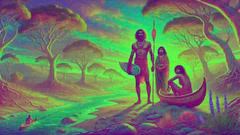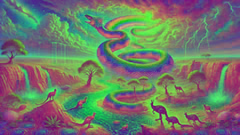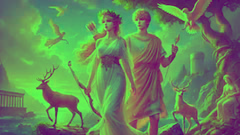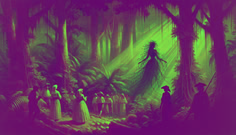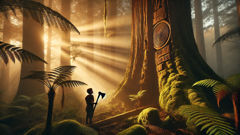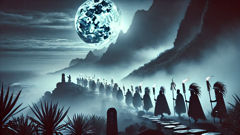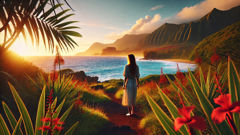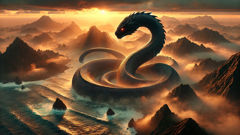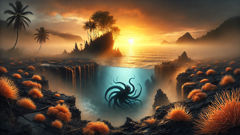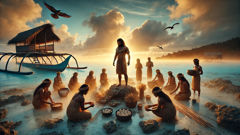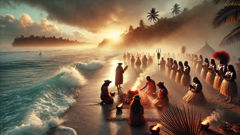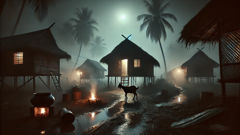Introduction
On the rim of the world where the sea gathers its blue breath and the sky leans low enough to dip a finger in the water, a pair of brothers walked the shoreline that would, in time, be called Fiji. The older, Vailevu, carried the steady patience of coral—his hands creased like tideworn rock—and the younger, Lomalagi, moved with the quick, bright energy of a wind-swept reef. They were the sons of a captain who read the stars like braille and a mother who stitched rituals into the hems of skirts. When the brothers were still young, their village was small as a shell: a few fale with woven roofs, a yam patch, a taro swamp, and fishermen who spoke to the reef as a relative. But beyond the lagoon there was a shadow that troubled the tides. Fishermen told of lines of white foam where the sea boiled and of distant thunder that held no clouds. Nets came up cut and empty; canoes that left at dawn sometimes did not return. The elders muttered about bad omens, the way certain seas can hide an ancient hunger. Vailevu and Lomalagi listened to these stories and felt the slow tightening of worry like a belt. It was said then that the world was still young and easily shaped, that the bones of the earth could be rearranged by great forces: wind, fire, the will of the gods, and serpents older than memory. So when the sea one evening opened with a sound like a hundred shells breaking together and something vast rose from the deep—a serpent the size of a mountain, scales flashing like black obsidian—fear took the village like a gust. Crops wilted under its shadow. Rivers changed course. The sea seemed to tremble, and with each coil the serpent swallowed islands whole or spat them out as if testing the taste of land. Many would have fled, but Vailevu and Lomalagi felt instead a different pull. Their family had always answered the ocean’s urgings, and now the ocean asked for courage. They read the signs their elders had taught them: the patterns of birds, the way the pandanus leaves pointed to safe passage. They bound themselves with sennit cord, braided their hair with kava leaves, and vowed to stand between the serpent’s hunger and their people. Their decision was not theater, but the slow gathering of resolve. They knew the risks—stories of heroes ending as boulders or being swallowed whole lay like middens in their minds—but they also knew that myths were not mere tales; they were instructions. The brothers' journey would stitch together sea and stone, challenge the anatomy of fear, and, in the end, render the islands into a story that bent the map. It is this story—how two ordinary brothers met an extraordinary serpent, how their choices changed the face of the ocean, and how from their trial arose the customs, the plants, and the first songs of the people—that has traveled on the currents to this day. Listen with salt on your lips and sand between your toes; listen as if the wind itself is curious. The tale begins at twilight, when the reef is a ledger of light and shadow and the serpent's song arrives like thunder from beneath the world.
The Rising and the Oath
When the serpent first breached the surface, the world stilled as though someone had placed a hand over the heart of the sea. It was not merely a fish or a monster in the way the children would later imagine; it was a thing older than names, an organism of such proportion that it seemed to carry the clock of the deep in its bones. Its eyes were like two polished seeds of night, reflective and intent. The village craned toward that new darkness, and for many nights prayers spilled into the open sky like oil. Vailevu and Lomalagi, watching the elders’ worry wrinkle their faces, understood that waiting would not mend what bellowed at the ocean floor. On the second night, the brothers stole a canoe and paddled out past reef and sandbar, where the water grew an indecent shade of blue, where the sea floor dropped into uncharted hunger. The moon, hesitant, offered a sliver of counsel. The brothers moved in the rhythm their father had taught them: pull, breathe, listen. They read the swell like a living script. When they found the serpent, it lay coiled across a field of underwater stones, coils piled like mountains bunched against a sky of water. Lomalagi wanted to shout, to strike, to end the thing quickly and break the chain of suffering. Vailevu, steadier, listened to the way the serpent exhaled—long, patient, and knowing—and chose a different opening. He asked the creature aloud why it had risen and what hunger it carried. The serpent's voice was not so much a sound as a changing of pressure in the cavity of the sea. It spoke of an old wound: once, the serpent said, the deep had been neighbor to a great sky-god who plucked islands like fruit and tossed them into the sea. The serpent had lived when land was rare and cherished, and now the sky swallowed many of the places the serpent had kept as his kin. His hunger, older than the brothers, was simple and terrible: a need to find a place to coil and rest. When Vailevu and Lomalagi learned this, they understood that the conflict was as much about place as it was about pride. They could have tricked the serpent with nets of prayer, could have bartered the village's last yams, or called on higher gods to pin the beast beneath rocks. Instead Vailevu proposed a third way—one that would demand sacrifice and cunning in equal measure. They returned to the village and called for a council under the breadfruit tree. There, elders who had once been canoe captains and mothers who had sewn the first cloaks weighed the choices. The ocean had already paid taxes in grief: reefs were scoured, gardens salted, and children had begun to whisper of lost cousins swallowed by surges. In that gathering, the brothers spoke of a plan they would carry alone. They would not slay the serpent in simple violence; they would attempt to change its path. With ropes, with firestones, and with chants half-sung and half-priestly, they planned to guide the serpent toward the edges of the deep where the water met the slow, patient bulwark of mountains. The hope was not to kill but to redirect, to invite the serpent to coil where its body could be both prison and cradle. People gave them offerings—pandanus baskets of yams, skirts trimmed with sea shells, and a piece of their trust. The air smelled of roasted taro and of salt. Before dawn, with the first mourning of the frigatebirds, Vailevu and Lomalagi paddled out again. They carried with them a spear fashioned from hardwood whispering like a drumstick, an anchor made from a reef-lashed carapace, and a talisman their mother had embroidered with patterns of waves and family. The brothers sang as they rowed: songs their grandmother had taught them about boundary and courage. The serpent, when it saw them, coiled in amusement and hunger in ways invisible to human eyes. Lomalagi tempted it with bright offerings—a raft of flaming coconut husks that sent smoke like a comet across the water—while Vailevu read the currents and guided their canoe within reach of the beast's flank. This was not a simple ambush. It was a negotiation with force. The brothers knew the risk: even a successful reroute might break a body, drown the brothers, or scatter islands forever. Yet beneath that fear lay a fiercer thing: a responsibility to those ashore who had trusted their words. The plan required the serpent to strike at the raft. Lomalagi's flame drew the beast's attention. In the explosion of spray and steam, Vailevu let the anchor sink into the serpent's coils and sang a binding chant. The line bit into scales like a fisherman into a stubborn fish. The brothers pulled with a precision born of years of paddling against wind. Their muscles burned; their breath became a language of its own. The serpent writhed, and the world responded: waves rose to applaud and cliffs answered with small avalanches. The brothers' hands—cracked from rope and salt—held the line until Vailevu saw a rhythm in the serpent's movement and called to Lomalagi. It was time to lead, not to fight. With the anchor as both leash and hinge, they guided the serpent toward a chain of shallow shoals where the water thinned and the beast could no longer twist freely. There, the serpent slowed as if tasting new soil. The brothers chanted until their throats rasped. And when the first coil finally struck the last reef, something remarkable happened: the serpent did not retreat. Instead, it pressed its body across the shallow water and began to weep—tears like brine and pearls—until its sobs filled the lagoon. Whether it was exhaustion or sorrow, the serpent's sound intertwined with the brothers' songs and the murmurs of the sea. The reef, pressured by the beast's weight and softened by its secretions, cracked in long, articulate seams. From those seams great blocks of stone and sand were loosened and rolled outward like seeds. The brothers watched, astonished, as pieces of the world rearranged themselves. They had not killed the serpent; they had changed its place in the world. That change would have consequences beyond what any of them could imagine: islands would be sculpted from the serpent's pressure, forests would rise on those new soils, and life would claim the newly sheltered coves. By guiding the serpent, the brothers had traded a single monster for a scattering of land—land that could shelter people, feed fields, and host rituals. When they returned to the village, their hair salted and their skins thinned by sun and sea, people wept and cheered in the same breath. The elders spoke of balance and debt: the brothers' bravery had birthed land, but the serpent had been altered, and the brothers had bound themselves to a covenant. Vailevu and Lomalagi agreed to a vow tested that night under the stars: they would watch the places that had been carved and teach future generations how to live with the memory of the serpent's body beneath their feet. They would plant taro upon the soils churned by the beast and teach songs to remind people to respect the deep. The oath became law of household and hearth. Their story would be sung by fishermen and mothers and later written into the dances that children learned with sticky fingers. Yet the serpent's presence could not be forgotten, nor could the change be fully controlled. The newly formed islands bore both gift and reminder: in the sound of the tide there was an old groan; when the wind cut across the coconut palms it sometimes spoke as if telling secrets that were not quite its own. The brothers, now older by a few storms and by one impossible engagement with the deep, walked among the newly born shores with light footsteps, listening for the old rhythm. And sometimes, in the lull between dawn and work, they'd sit and sing to the place where the serpent lay coiled, both to honor a powerful creature and to ask forgiveness for the shaping they had demanded. It is from these acts—of guidance, of negotiation, of promise—that the islands in this tale take their first breath.
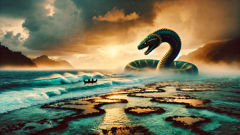
From Scales to Soil: The Making of People and Practices
After the serpent settled—its body pressed into the shoals like a sleeping mountain—the world found a new cadence. The first rains fell differently on the fresh curves of sand and stone; puddles pooled where none had been before and brackish water mixed with sweet in odd rhythms. In that newly altered geography, seeds took chances. The villagers discovered that certain vines, once listless in the deeper soils, rooted quickly in the serpent-softened ground. Breadfruit trees took hold in places that had earlier been too saline. Creatures that avoided humans found nooks on the serpent's back where freshwater trickled from its scales like tears—fresh ponds coalesced on ridged skin. To the people, this was not accidental. It was a conversation answered: the sea and the serpent and the brothers' courage had traded a fragment of primal order for hospitable land. The brothers, seeing the life that grew in the wake of their action, understood that creation was more than making hard things exist; it was teaching how to live on them. Their oath, now a village practice, evolved into rituals and crafts. Lomalagi, who had always been nimble with his hands, began to pattern mats that traced the serpent's circumference in woven sennit, reminding weavers that the islands were born from a curve and a binding. Vailevu took to carving small figures from the first fallen coconut wood; each figure had a small notch to rest a pinch of kava on, a way to give thanksgivings to both the sea and the memory of their long-bodied neighbor. Children learned tales of how their grandparents had carried seeds from the old shores and planted them on new ones. They were taught to sing those songs while they worked, songs with refrains that mimicked the serpent's low moan and chanted the names of the plants that had followed in its wake. Those songs became a kind of map: if you sang the right pattern the breadfruit tree would nod; if you hummed the salt-children lullaby, the turtle might come inland to lay. Over seasons, what had been a single village grew into a collection of hamlets linked by causeways and canoe routes that wound like ropes. The people began to notice that some places were richer than others—soil near the serpent's head had a different mineral shimmer, and fish congregated in certain lagoons with unusual fidelity. The elders wrote these observations into an oral ledger, passing them along at weddings and funerals so no knowledge would be lost. A new kind of navigation emerged, a navigation of memory: elders could tell you where the serpent's scale had cracked into an inlet and where to plant yams so they would be kissed by fresh mist. With land came law, and with law came responsibility. There were rules about how to harvest from the serpent-made coves. No one was to take more than needed; no fire was to be left on the reef at night because sparks could wake a sleeping coil; infants were to be named after the place where they were born, binding child to land. The brothers became custodians of such laws. When disputes arose—over a piece of reef or a beach that seemed to favor one family—the brothers would sit in the middle of the village and recall their own bargain with the serpent: 'We asked for place and promised to watch it.' Their decisions were gentle but binding, built on a sense that the land itself had a kind of personhood and deserved respect. This idea—that a living force underlay the islands—shaped the people's relationship to the sea’s gifts. Fishing became an act of dialogue rather than domination. Before a net was cast, fishermen would offer a small portion of the first catch back to the place, calling it by the name sewn into their grandmother's song. Planting and harvesting followed this ethic: the first of every harvest was always offered outward, toward the sea, as thanks and as an acknowledgment the islands were not simply ground but the consequence of a negotiated history. People also began to understand themselves as stitched to the serpent's fate. In the years after the great guiding, storms still came; heavy weather could make the serpent thrash and create sudden currents that tested nets and patience. Yet in those same storms, there was often new opportunity—sandbars formed, exposing beds of shellfish that fed many for months. The myth taught that loss and gain were siblings. It demanded that the community keep its balance in the face of nature's flipping moods. The brothers, who had once been young and reckless, aged into wise storytellers. They traveled between the hamlets, teaching songs that taught survival—how to read a braided tide, how to make a canoe that would sing with the sea rather than fight it, how to create leis for newborns using the first moss that grew on the serpent's scales. Kava ceremonies evolved to include a verse meant to placate the serpent and to name the part of the island a family claimed. Over generations, these rituals hardened into custom, and people who came later assumed the islands had always existed that way, forgetting the labor of their making. Yet the old songs remained. In times when new islands rose after earthquakes or when unfamiliar currents brought strange fish, elders would hum the brothers' binding chant and remind the young that the world could still be reshaped by courage and wisdom. And not all transformations were of land and law. The brothers' story shaped the very way people saw kinship and bravery. A child who helped retrieve a net from a dangerous current was praised with the same name once given to Vailevu for steadiness; a young canoeist who guided a stranger safely to shore could be called after Lomalagi, for quick wit. Thus the tale became a moral architecture: bravery without thought could lead to ruin; cleverness without care could be cruel. The right blend brought shelter and harvest. The serpent itself kept to its slumbering places, and though its body sometimes shifted in the midst of storms, the community honored it. They did not attempt to bind it again, knowing the cost of such control. Instead they built altars at the edges of their villages—small piles of shells and stones topped with woven mats—where they left offerings at the turning of seasons. At night, when the moon pulled the sea and reefs sang their glassy songs, people would stand at the waterline and listen, finding in the dark a pulse that felt like continuity: a reminder that the world had been shaped by deliberate hands and that their lives were part of a longer story in which negotiation with forces larger than oneself was the most human act. Over time, travelers from distant atolls came to study the practices of these people. They learned how to coax breadfruit from stubborn soil and how to build houses that breathed with the wind. They learned that the islands were not merely geography but an ethic carved into stone, and they carried those lessons elsewhere like seeds. The brothers' names became words in the language of navigation and of household law; their chant swelled into a chorus that taught people to see their environment not as an enemy to be subdued but as a companion that required listening, offerings, reciprocity, and care. In this way, the myth of two brothers and a great serpent was more than a story about monsters or islands; it was a manual for living in a fragile world, a template for how communities might make and keep the places they need without erasing the rights of the world that cradled them.

Conclusion
Generations after Vailevu and Lomalagi walked the shores, the islands wore their stories like layers of living cloth. People who lived on those lands told of the serpent in all kinds of ways: as ancestor, as neighbor, as a teacher that had refused simple obedience and instead offered a different sort of gift—land shaped by negotiation, not conquest. The brothers' names passed into songs mothers hummed at dawn and into the quiet curses of fishermen in sudden squalls. Their vow to watch became an ethic of stewardship: never to take the sea for granted, never to assume the earth would remain unchanged without care. When new challenges arrived—cyclones, changing tides, strangers with different customs—the people returned to the original bargain, touching the carved figures Vailevu had made, humming the river-songs Lomalagi had kept. In those sounds they found a reminder that origins are not only about beginnings, but about how descendants remember, adapt, and hold themselves to their promises. Today, when visitors come to those islands and stand on the same reef where two brothers once risked everything, they often report an odd sensation: a low thrum beneath the feet, as if the land kept the memory of the serpent's breath. Whether that thrum is wind, tectonic murmur, or the echo of a vow no one forgot matters less than the lesson it imparts. The legend endures because it answers a question every islander knows: how to make a home in a world that will not stand still. It teaches that creation is as much a communal act as a miracle, that courage must be tempered by listening, and that the living earth demands reciprocity. So the people of those islands continue to plant with gratitude, to sing to the shoreline, and to pass down a story that binds them not only to each other but to the deep, slow life beneath their feet. The two brothers' legacy is not a monument of stone but the ongoing work of tending—to soil, to song, and to the fragile contract between human need and nature’s vast appetite. Listen, and you might hear them in the hush between the waves: a promise that once and forever shaped these isles, taught a people how to be, and reminded every generation that the sea remembers those who honor its bargains.


